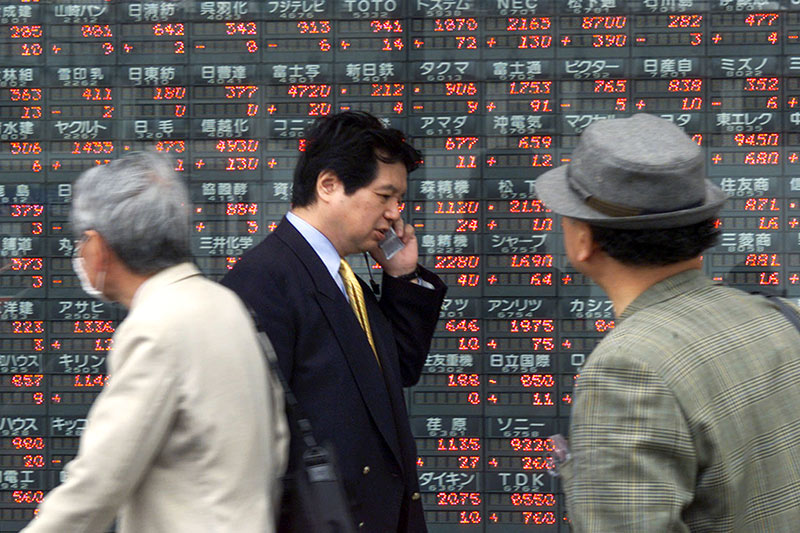Investing.com - Asian shares took their cues from their U.S. counterparts Tuesday and sold-off a day after U.S. equities suffered through the worst one-day performance since November 2012.
In Asian trading Tuesday, Japan’s Nikkei 225 dropped 1.10% as traders continue to shift out of riskier fare amid a spate of concerning data points delivered Monday by some of the world’s largest economies.
Hong Kong’s Hang Seng slid 0.80% while the Shanghai Composite fell 0.06%. On Monday in Asia, data out of Beijing revealed that the Chinese gross domestic product expanded by 7.7% year-on-year in the three months to March, down from 7.9% in the fourth quarter and well below expectations for 8.0% growth.
A separate report showed China’s industrial production grew 8.9% on-year in March, below market calls for 10.0% growth and also below a 9.9% reading in February. Chinese retail sales, on the other hand, grew 12.6%, beating market consensus for a 12.5% reading as well as February's 12.3% rate.
As if those data points were not enough to spook investors, the New York Federal Reserve’s Empire State Manufacturing Survey fell to 3.05 this month, well below expectations for a reading of 7 and last month’s reading of 9.24. The general business conditions index slipped six points to 3.1.
The National Association of Home Builders said its home builder confidence index rose to 42 this month from 24 in April 2012. A reading of 50 is considered to be the dividing line between positive and negative. Both of those data points were released during Monday’s U.S. session. The U.S. and China are the world’s two-largest economies.
The global commodities plunge weighed on Australia’s S&P/ASX 200, which fell 0.7%. Mining and materials names, including BHP Billiton, were among the losers in Australia Tuesday.
New Zealand’s NZSE 50 dropped 0.76% while Singapore’s Straits Times Index fell 0.30%. South Korea’s Kospi tumbled 1.08% even after the country proposed a USD17.2 billion stimulus package aimed at bolstering economic growth. South Korea’s Finance Ministry said the package will increase GDP by 0.3% and create 400,000 jobs.
S&P 500 futures gained 0.40% a day after the benchmark U.S. index plunged 2.30%.
In Asian trading Tuesday, Japan’s Nikkei 225 dropped 1.10% as traders continue to shift out of riskier fare amid a spate of concerning data points delivered Monday by some of the world’s largest economies.
Hong Kong’s Hang Seng slid 0.80% while the Shanghai Composite fell 0.06%. On Monday in Asia, data out of Beijing revealed that the Chinese gross domestic product expanded by 7.7% year-on-year in the three months to March, down from 7.9% in the fourth quarter and well below expectations for 8.0% growth.
A separate report showed China’s industrial production grew 8.9% on-year in March, below market calls for 10.0% growth and also below a 9.9% reading in February. Chinese retail sales, on the other hand, grew 12.6%, beating market consensus for a 12.5% reading as well as February's 12.3% rate.
As if those data points were not enough to spook investors, the New York Federal Reserve’s Empire State Manufacturing Survey fell to 3.05 this month, well below expectations for a reading of 7 and last month’s reading of 9.24. The general business conditions index slipped six points to 3.1.
The National Association of Home Builders said its home builder confidence index rose to 42 this month from 24 in April 2012. A reading of 50 is considered to be the dividing line between positive and negative. Both of those data points were released during Monday’s U.S. session. The U.S. and China are the world’s two-largest economies.
The global commodities plunge weighed on Australia’s S&P/ASX 200, which fell 0.7%. Mining and materials names, including BHP Billiton, were among the losers in Australia Tuesday.
New Zealand’s NZSE 50 dropped 0.76% while Singapore’s Straits Times Index fell 0.30%. South Korea’s Kospi tumbled 1.08% even after the country proposed a USD17.2 billion stimulus package aimed at bolstering economic growth. South Korea’s Finance Ministry said the package will increase GDP by 0.3% and create 400,000 jobs.
S&P 500 futures gained 0.40% a day after the benchmark U.S. index plunged 2.30%.
